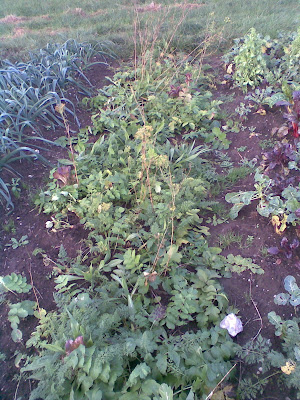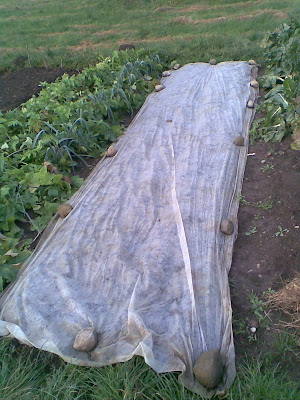 The growth of the green manure has come on quite a bit in the last two weeks.
The growth of the green manure has come on quite a bit in the last two weeks.
Monday 3 December 2007
Week 49 - Bed PC4
Week 49 - Bed PC3
Week 49 - Bed PC2
Week 49 - Bed PC1
Week 49 - Bed DD8
Week 49 - Bed DD7
 We finally cleared the old pea plants out of this bed and failed to find any nitrogen fixing nodules on the roots. It is possible that any nodules that formed had fallen off when the plants died, but we suspect that the specific bacteria that form these beneficial nodules are not in this soil. This field contains many clover plants which have the nodules, but it is a different but species which forms the symbiotic relationship with plants from the bean and pea family.
We finally cleared the old pea plants out of this bed and failed to find any nitrogen fixing nodules on the roots. It is possible that any nodules that formed had fallen off when the plants died, but we suspect that the specific bacteria that form these beneficial nodules are not in this soil. This field contains many clover plants which have the nodules, but it is a different but species which forms the symbiotic relationship with plants from the bean and pea family.This absence would make sense, given that peas and beans probably have not been grown in this field for many decades. The lack of this extra source of nitrogen probably reduced the yield of the peas. We will have investigate how to inoculate the soil before the next sowing of peas and beans.
Week 49 - Bed DD6
Week 49 - Bed DD5
Week 49 - Bed DD4
 We cultivated this bed to remove the few struggling seedlings and weeds and sowed two long rows of:
We cultivated this bed to remove the few struggling seedlings and weeds and sowed two long rows of:- Aquadulce Claudia Broad Beans (two double staggered rows, 48 seeds) - an excellent autumn sowing variety which establishes itself very quickly and will produce a very early crop. It is white seeded with pods up to 23 cm long.
Week 49 - Bed DD1
 We finally double dug this bed and cleared the section to the west (left side of photo) of grass which we added as fertility on top of the lower level that we loosened. We added a few buckets of well rotted horse manure, and this bed is not ready for planting, though we should add some more compost or other source of fertility in the spring.
We finally double dug this bed and cleared the section to the west (left side of photo) of grass which we added as fertility on top of the lower level that we loosened. We added a few buckets of well rotted horse manure, and this bed is not ready for planting, though we should add some more compost or other source of fertility in the spring.
Week 49 - Bed EX8
 We finally cleared out the remains of the peas and broad beans, and as with elsewhere in the plots, there were not any nitrogen fixing nodules. It seems that the specific beneficial bacteria that form these symbiotic nodules on the roots of the peas and beans is not present in the soil of this field. This would make sense given that peas and beans have not been grown in this field for decades.
We finally cleared out the remains of the peas and broad beans, and as with elsewhere in the plots, there were not any nitrogen fixing nodules. It seems that the specific beneficial bacteria that form these symbiotic nodules on the roots of the peas and beans is not present in the soil of this field. This would make sense given that peas and beans have not been grown in this field for decades.The poor yield peas and beans is probably due to this lack of additional nitrogen. We will have to find a way of introducing these bacteria to the soil before we plant any more peas.
Week 49 - Bed EX7
 We finally pulled out the remains of the peas and broad beans at the far end of the bed and found that there were no nitrogen fixing nodules. This was the same with other plots and it seems that this does not have any of the bacteria species particular to the pea andbean family of plants. This absence would make sense, given that peas and beans probably have not been grown in this field for many decades. The lack of this extra source of nitrogen probably reduced the yield of the peas. We will have investigate how to inoculate the soil before the next sowing of peas and beans.
We finally pulled out the remains of the peas and broad beans at the far end of the bed and found that there were no nitrogen fixing nodules. This was the same with other plots and it seems that this does not have any of the bacteria species particular to the pea andbean family of plants. This absence would make sense, given that peas and beans probably have not been grown in this field for many decades. The lack of this extra source of nitrogen probably reduced the yield of the peas. We will have investigate how to inoculate the soil before the next sowing of peas and beans.The ryegrass that we sowed as a cover crop is doing well, at least in the area that had been empty, but there is still no sign of clover or vetch.
Week 49 - Bed EX6
Week 49 - Bed EX5
Week 49 - Bed EX4
Week 49 - Bed EX3
Monday 19 November 2007
Week 47 - Bed PC8
Week 47 - Bed PC7
Week 47 - Bed PC5
Week 47 - Bed PC4
Week 47 - Bed PC3
Week 47 - Bed PC2 Planting
We finished digging the bed (one spade depth) and incorporated 70L of well rotted horse manure. Into the resultant raised bed we planted a scattered mix of:
- Red Onion Sets - overwintering bulb onion (not sure which variety).
- Senshyu Onion Set - a Japanese overwintering variety, semi flat shaped with yellow/brown skins which mature in late June.
Week 47 - Bed PC1 Planting
We cultivted this bed, removing quite a bit of stone from the lower level, but have not yet added any additional fertility. We will need to top dress this bed in the spring. Into the prepared bed we planted:
- Messidrome Garlic - a large overwintering garlic variety, with regular bulbs that are pink or pink marked.
Week 47 - Bed DD8
Week 47 - Bed DD7
Week 47 - Bed DD5
Week 47 - Bed DD4
 With the exception of a few scattered seedlings, nothing has grown in this bed (or else everything that sprouted has been eaten). This is possibly due to the cool conditions, or the low light levels under the fleece that covered the bed for a few weeks. A polytunnel might have helped. We will likely resow this bed with some overwintering plants.
With the exception of a few scattered seedlings, nothing has grown in this bed (or else everything that sprouted has been eaten). This is possibly due to the cool conditions, or the low light levels under the fleece that covered the bed for a few weeks. A polytunnel might have helped. We will likely resow this bed with some overwintering plants.
Week 47 - Bed DD3
Week 47 - Bed EX6
Week 47 - Bed EX4
Week 47 - Bed EX1
 The plant on this bed were cleared a few weeks ago and the grass that had grown around the edges was dug up and piled on top. The two big stones were dug out of the adjacent bed EX2 when it was double dug. There is a lot of stones in this field (most of them much smaller than these) that form a dense layer about 25-30 below the surface.
The plant on this bed were cleared a few weeks ago and the grass that had grown around the edges was dug up and piled on top. The two big stones were dug out of the adjacent bed EX2 when it was double dug. There is a lot of stones in this field (most of them much smaller than these) that form a dense layer about 25-30 below the surface.
Monday 12 November 2007
Week 46 - Bed EX2 Planting
We cleared all of the dying plants off of this bed to prepare it for planting overwintering onions and garlic.
This bed was originally dug less than 6 months ago as a rough lazy bed by turning over the sod and loosing up the surface without adding any additional fertility. A very quick method of starting a garden, but not the best for the first planting. This time double dug this bed and removed a number of large stones and many smaller ones that had formed a hard pan about 25cm below the surface. This would have prevented the roots from easily reaching deep in the soil and restricted the availability of nutrients and water, reducing the yield and possibly stressing the plant during droughts. The original sod was mostly decomposed, but remnants of the roots still remained.
We mixed in approximately 60L of well rotted horse manure and created a relatively smooth seedbed into which we sowed one long row each of:

This bed was originally dug less than 6 months ago as a rough lazy bed by turning over the sod and loosing up the surface without adding any additional fertility. A very quick method of starting a garden, but not the best for the first planting. This time double dug this bed and removed a number of large stones and many smaller ones that had formed a hard pan about 25cm below the surface. This would have prevented the roots from easily reaching deep in the soil and restricted the availability of nutrients and water, reducing the yield and possibly stressing the plant during droughts. The original sod was mostly decomposed, but remnants of the roots still remained.
We mixed in approximately 60L of well rotted horse manure and created a relatively smooth seedbed into which we sowed one long row each of:
- Messidrome Garlic - a large overwintering garlic variety, with regular bulbs that are pink or pink marked.
- Red Onion Sets - overwintering bulb onion (not sure which variety).
- Senshyu Onion Set - a Japanese overwintering variety, semi flat shaped with yellow/brown skins which mature in late June.

Subscribe to:
Comments (Atom)








































